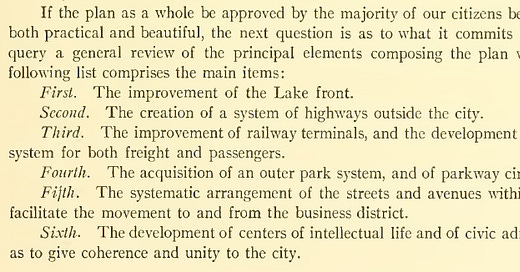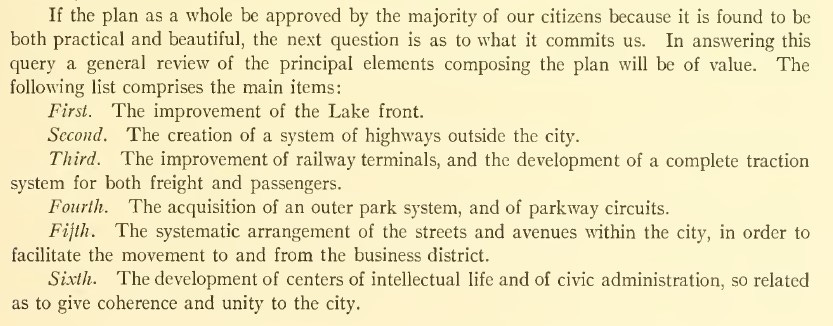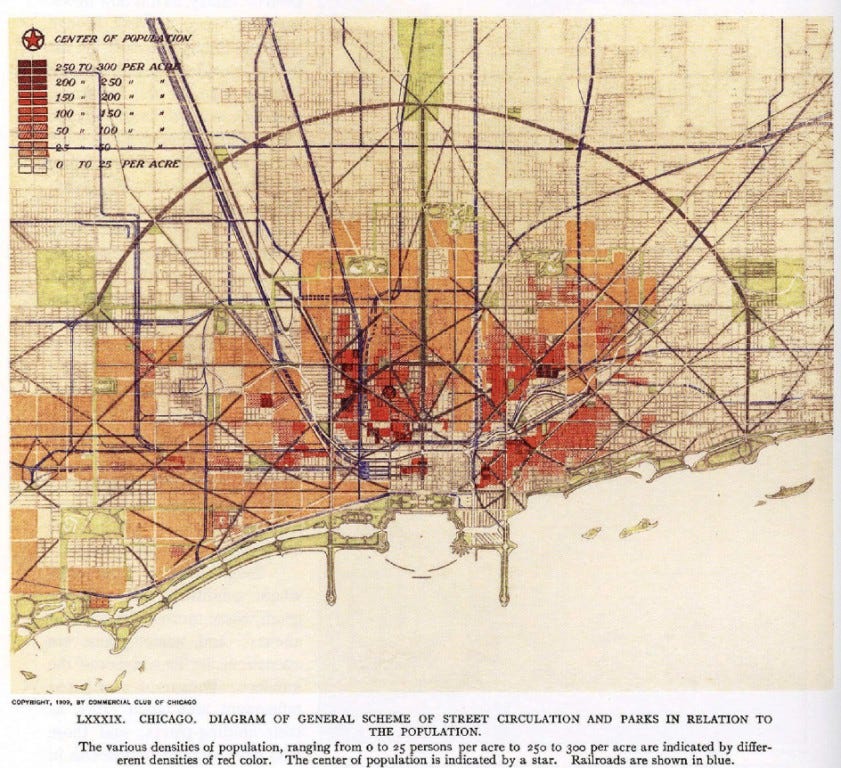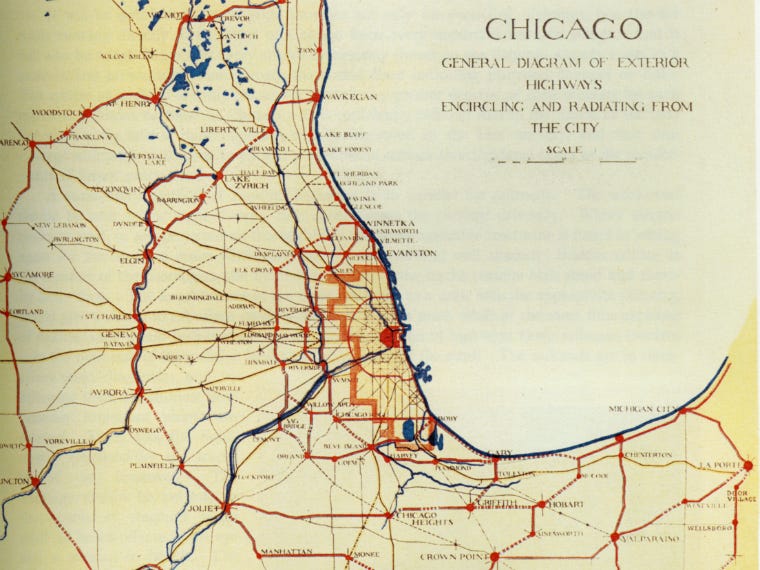Plan of Chicago 1909
My notes on Germany 1648 to 1806 , Germany 1800 to 1840s , Waikato the golden age 1840s to 1850s , Waikato 1860s , Gentry & Speculators , The beginning of modern planning: Water, Sewage, Housing, Transport, City Centre, Markets and Zoning, 1890s: Introduction, Dwellings & Lots, Reason for Zoning, Horses, Cyclists & road deaths, York, City beautiful & genesis of motorways, Garden City, Dresden 1903,
Plan of Chicago 1909; by Daniel H. Burnham and Edward H. Bennett
Daniel Burnham was a leading figure in the planning of the 1893 Chicago Fair, focused on the theme of ‘the white city’, and the City Beautiful movement that followed it. This ‘plan of Chicago’ added extra future cost, providing highways for automobiles and placing other responsibilities on city leaders for preventing slums, and providing parks. With regard to automobiles, ‘The rapidly increasing use of the automobile promises to carry on the good work begun by the bicycle in the days of its popularity in promoting good roads and reviving the roadside inn as a place of rest and refreshment. With the perfection of this machine, and the extension of its use, out-of-door life is promoted, and the pleasures of suburban life are brought within the reach of multitudes of people who formerly were condemned to pass their entire time in the city’ (p.72). The authors of the plan also knew that lower speeds could reduce the cost of road maintenance, ‘[with] reference to highway building - heavy automobile travel ... A very moderate speed limit for automobiles will keep roads in good repair, for it is the high speed of the machine that is so destructive to road beds’ (p.67). Here is the example the authors use: ‘...in France two years ago, the main road from Versailles to Chartres was in first-class condition; going over the same road in June, 1907, it was found to be almost impassable, the wear upon it having come from automobiles; and yet this highway was constructed with care’ (notes at bottom of page 67), and here is a recommendation: ‘It is highly important that the city should be able effectively to control the traffic on streets and boulevards, and especially to keep designated residence streets free from heavy teaming’ (p.246).
Slums: ‘The remedy is the same as has been resorted to the world over: first, the cutting of broad thoroughfares through the unwholesome district; and, secondly, the establishment and remorseless enforcement of sanitary regulations which shall insure adequate air-space for the dwellers in crowded areas, and absolute cleanliness in the street, on the sidewalks, and even within the buildings. The slum exists to-day only because of the failure of the city to protect itself against gross evils and known perils, all of which should be corrected by the enforcement of simple principles of sanitation that are recognized to be just, equitable, and necessary’ (p.174).
Parks: Burnham and Bennett were both well-travelled and mention parks in London, Paris, Berlin, Vienna (p.82-83) and they provide a benchmark for measuring needed park area - ‘For health and good order there should be one acre of park area for each hundred people’ [247 people per hectare] (p.74). ‘Density of population beyond a certain point results in disorder, vice, and disease, and thereby becomes the greatest menace to the well-being of the city itself, as a measure of precaution, therefore, the establishment of adequate park area is necessary’ (p.82). Hamilton has 1,412 hectares (3,489 acres) of open space and a population of 141,612 (2013 census), which equates to 100 people per hectare or 40.5 people per acre of park land. Link - Hamilton City council – Open Space Plan Sep 2013
Density leading to Disorder and Vice: the reference provided in the plan states ‘In the City of London a thousand policemen are detailed to guard the five thousand and more buildings left entirely empty each night’ (p.65), which is similar to what Engels observed in Manchester in the 1840s: ‘nearly the whole [central] district is abandoned by dwellers, and is lonely and deserted at night; only watchmen and policemen traverse the narrow lanes with their dark lanterns. This district is cut through by certain main thorough fares ... lined with brilliant shops. In these streets the upper floors are occupied, here and there’ (Engels p.58), which shows the negative effect of removing dwellings from the centre of cities; even with upper floor living the emptiness at street level is uncomfortable.
The Condition of the Working Class in England by Friedrich Engels – 1840s
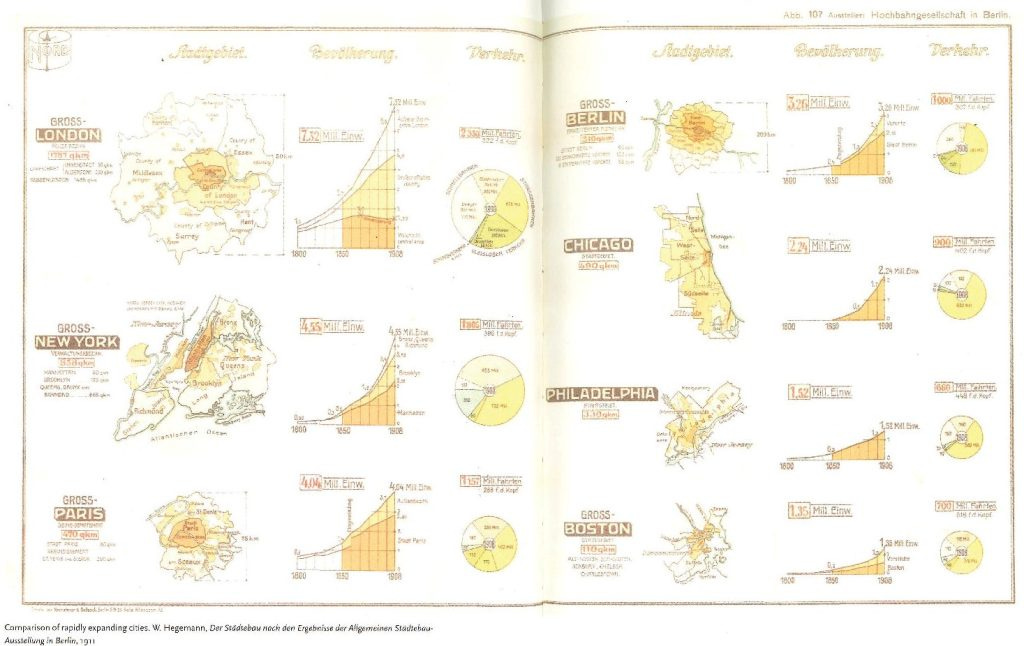
Density of population beyond a certain point: what is this point? - As a reference to the cities the plan does mention, the 1911 population density using the image above puts London at 4,096ppkm2 (17 people per acre),New York 5,429ppkm2 (22ppa), Paris 8,595ppkm2 (35ppa), Berlin 10,516ppkm2 (43ppa), Chicago 4,571ppkm2 (18ppa), Philadelphia 4,606ppkm2 (27ppa), and Boston 12,272ppkm2 (50ppa), In contrast, in 2018 Hamilton NZ had a population density of 1,450 ppkm2 (6ppa), Boston, with the highest density gets praise for having ‘developed the most extensive park system in America’ (p.27). Others are noted for ‘adding to their population at an unprecedented rate. Coincident with this urban development there has been a widespread increase in wealth’ (p.1) ... Chicago may well take a lesson from Berlin, where the streets are clean by daily washing, and where a property owner may build on only two-thirds of his land, leaving the remainder for a court’ (p.109). The Chicago plan’s answer to preventing going over that certain point is measurement by parks acreage per head of population.
End note: 'Perhaps still more striking was the experience of Chicago where the public spirited members of the Commercial Club spent over $100,000 in financing the late. Daniel H. Burnham’s report on a city-plan, beautifully printed and wonderfully illustrated.' Page 51 of 'Report on a city plan for the municipalities of Oakland & Berkeley' – by Werner Hegemann

